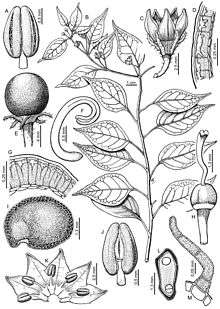Capsicum eximium
Capsicum eximium is a member of the genus Capsicum with 2n=2x=24, and native to the New World, specifically the Andean region of South America.[1] It is one of the "purple-flowered" Capsicums along with Capsicum cardenasii and Capsicum pubescens.[2] Like most other chili peppers, it is both pungent and self-compatible.[3] It is a member of the Pubescens complex, a natural group of highly related Capsicums.[4] Natural hybrids between C. pubescens as well as C. tovarii have been found, further supporting the relationship of these species.[5]
| Capsicum eximium | |
|---|---|
 | |
| Botanical diagram of Capsicum eximium | |
| Scientific classification | |
| Kingdom: | Plantae |
| Clade: | Tracheophytes |
| Clade: | Angiosperms |
| Clade: | Eudicots |
| Clade: | Asterids |
| Order: | Solanales |
| Family: | Solanaceae |
| Genus: | Capsicum |
| Species: | C. eximium |
| Binomial name | |
| Capsicum eximium Hunz | |
Plant description
Capsicum eximium is identified by its distinctive purple flowers. The flowers have an entire calyx and bell-shaped corolla that come in various shades of purple. Mature fruit of C. eximium are small, shiny, non-pulpy berries. The seeds are yellow.[6][7]
Uses
In Bolivia, where the plants occur naturally, C. eximium is used as a spice.[6] Also, since it is a wild pepper species, it has been used extensively in phylogenetic studies to better understand the relationships of peppers and different gene models.[1]
References
- Tewksbury, Joshua J.; Manchego, Carlos; Haak, David C.; Levey, Douglas J. (2006-03-30). "Where did the Chili Get its Spice? Biogeography of Capsaicinoid Production in Ancestral Wild Chili Species". Journal of Chemical Ecology. 32 (3): 547–564. doi:10.1007/s10886-005-9017-4. ISSN 0098-0331. PMID 16572297.
- Eshbaugh, W. Hardy; Smith, Paul G.; Nickrent, Daniel L. (1983-01-01). "Capsicum tovarii (Solanaceae), a new species of pepper from Peru". Brittonia. 35 (1): 55–60. doi:10.2307/2806051. ISSN 0007-196X. JSTOR 2806051.
- Onus, A. Naci; Pickersgill, Barbara (2004-08-01). "Unilateral Incompatibility in Capsicum (Solanaceae): Occurrence and Taxonomic Distribution". Annals of Botany. 94 (2): 289–295. doi:10.1093/aob/mch139. ISSN 0305-7364. PMC 4242164. PMID 15229125.
- Ince, Ayşe Gul; Karaca, Mehmet; Onus, A. Naci (2009-11-15). "Genetic Relationships Within and Between Capsicum Species". Biochemical Genetics. 48 (1–2): 83–95. doi:10.1007/s10528-009-9297-4. ISSN 0006-2928. PMID 19916044.
- Ibiza, Vicente P.; Blanca, José; Cañizares, Joaquín; Nuez, Fernando (2011-08-28). "Taxonomy and genetic diversity of domesticated Capsicum species in the Andean region". Genetic Resources and Crop Evolution. 59 (6): 1077–1088. doi:10.1007/s10722-011-9744-z. hdl:10251/80201. ISSN 0925-9864.
- Heiser, Charles B.; Smith, Paul G. (1958-10-01). "New species of Capsicum from South America". Brittonia. 10 (4): 194–201. doi:10.2307/2804950. ISSN 0007-196X. JSTOR 2804950.
- Zewdie, Y.; Bosland, P. W. (2003-07-01). "Inheritance of Seed Color in Capsicum". Journal of Heredity. 94 (4): 355–357. doi:10.1093/jhered/esg063. ISSN 0022-1503. PMID 12920108.